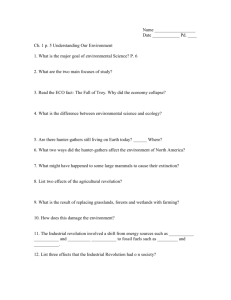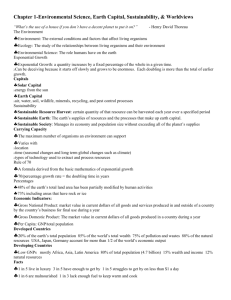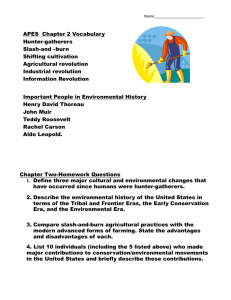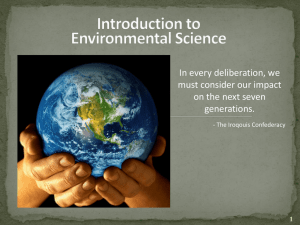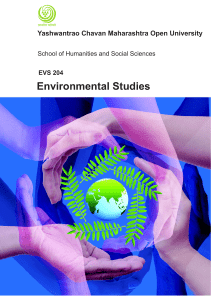ch.1_enviro
advertisement
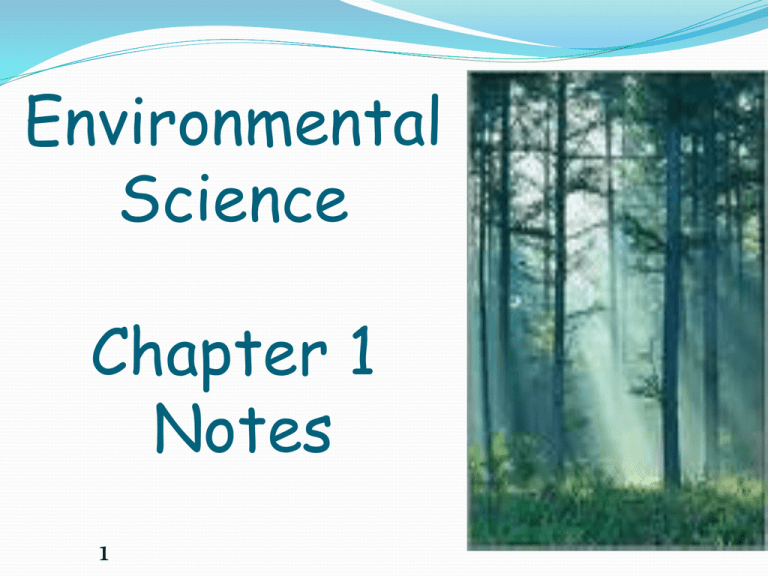
Environmental Science Chapter 1 Notes 1 Section 1: Science and the Environment 2 Environmental Science: Is a interdisciplinary field of science that draws from many sciences (as well as other fields) Ex. Biology, chemistry, ecology, geology, earth science, geography Is considered an applied science. Focuses on three main areas: conservation and protection of natural resources environmental education and communication environmental research 3 Biodiversity: The number and variety of species that live in the area. Earth has been home to millions of species. Yet only a fraction of those Renewable Resource: A resource that can be replaced relatively quickly by natural processes. ex. Fresh water, air soil, trees, crops species are alive today. Biodegradable: Are pollutants that can be broken down by natural processes. Ex: food waste Non-degradable: pollutants that cannot be broken down by natural processes. Ex: plastics, lead, mercury Mass Extinction: Large scale extinction (some natural Nonrenewable Resource: A resource that forms at a much slower rate than it is consumed and some man made) 4 Agriculture: The practice of growing, breeding, and caring for plants and animals that are used for food, clothing, housing, transportation, etc. Agriculture Revolution: Dramatic changes that impacted human societies and their environment when man began practicing agriculture more than 10, 000 years ago. Closed System: • Earth has been compared to a “spaceship” traveling through space, unable to dispose of waste or take on new supplies as it travels. • The only thing that enters Earth’s atmosphere in large amounts is energy from the sun. • The only thing that leaves is heat. 5 Species Extinction • Three popular theories as to how and why the megafauna (extremely large animals) ceased to exist in North America: The blitzkreig (overkill) : they were over hunted Rapid climate shifts associated with the last ice age Disease (similar to influenza or rabies) was introduced with the arrival of humans 6 Hunter-Gathers People who obtain food by collecting plants and by hunting wild animals / scavenging their remains Usually migrated from place to place Still some remain in Amazon rain forest Cleared grassland by setting fires 7 Which of the following was not caused by Hunter-Gatherers? A) Clearing of land B) Introduction of non-native species C) Smog and industrial waste D) Extinction of plants and animals 8 Impacts made by the hunter-gatherers Changed the landscape by moving plants. Skeletal remains of hunter-gatherers from as many as 20, 000 years ago show signs that these humans were responsible for the pollutions of their environment and even suffered deformities as a result. 9 Agricultural Revolution Caused human population growth, habitat loss, soil erosion, domestication of plants and animals Changed the food we eat Grasslands, forest, and wetlands were replaced with farmland (**habitats were destroyed) Caused floods, water shortage, infertile soil 10 Industrial Revolution 11 Few restrictions were placed on air pollution during I.R. (burning of fossil fuels became extensive – leading to major pollution) Humans and animals had powered tools for almost 10, 000 years (prior to I.R.) now machines do. Greatly increased the efficiency of agriculture, industry, and transportation Urban areas grew –people moved from farms Main Environmental Issues Resource depletion Pollution Loss of biodiversity 12 Section 2: The Environment and Society 13 “The Tragedy of the Commons” Written by Garrett Hardin (in 1968) Influential essay Described the relationship between the short-term interest of the individual and the long-term interest of society Overall point is that someone or some group has to take responsibility for maintaining a resource “If I don’t use this resource, someone else will.” 14 Earth’s Modern Commons are our “Natural Resources” Anything within the “Biosphere” World’s Oceans / Waterways ; Air ; Migrating Animals ; Forest ; Fossil Fuels / Nuclear Materials 15 Economics and the Environment Supply and Demand: the greater the demand for a limited supply of something, the more it’s worth. 16 Economics and the Environment Continued Cost benefit analysis: balances the cost of the action against the benefits one expects from it. The cost of environmental regulations are often passed on to the consumer. “The cost to clean up after an oil spill is added to the price of gas” Risk Assessment: a tool to help create cost-effective ways to protect our health and the environment. 17 Developed v’s Developing Countries Developed Country: have higher average incomes, slower population growth, diverse industrial economies, stronger support systems. Include US, Canada, Japan, and the countries of Western Europe Developing Countries: lower average incomes, simple and agricultural-based economies, and rapid population growth. Ex: Ethiopia, China 18 Population and Consumption Environmental problems in developed countries tend to be related to consumption. The major environmental problems in developing countries are related to population growth. 19 Ecological Footprint Shows the productive area of Earth needed to support one person in a particular country. It estimates the land used for crops, grazing, forest products, and housing. It also estimates the ocean area used to harvest seafood and the forest are needed to absorb the air pollution. 20 A Sustainable World Sustainability: the condition in which human needs are met in such a way that a human population can survive indefinitely. Is a primary goal of environmentalist. 21


